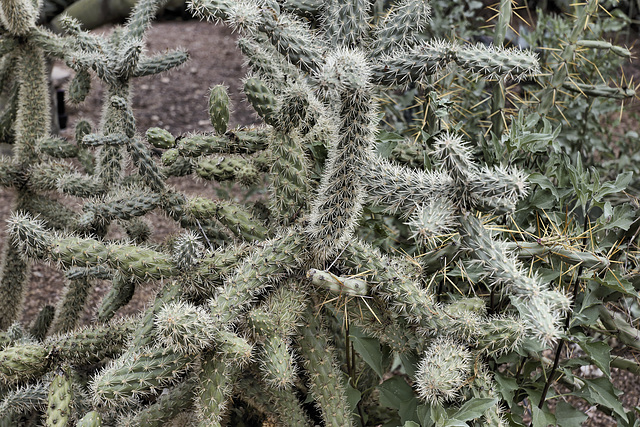
2016-7
Cactus Fruit, #2 – Desert Botanical Garden, Papago Park, Phoenix, Arizona
Cactus Fruit, #1 – Desert Botanical Garden, Papago Park, Phoenix, Arizona
A Prickly Inukshuk – Desert Botanical Garden, Papago Park, Phoenix, Arizona
Cylindropuntia spinosior, with the common names include cane cholla, spiny cholla and walkingstick cactus, is a cactus species of the North American deserts. It is native to Arizona and New Mexico in the United States; and Chihuahua and Sonora in Mexico. In Australia, the species is regarded as an emerging weed threat where it is known as snake cactus. It is a declared noxious weed in New South Wales where it was first observed in 2000/2001. It is also naturalized in South Australia and Queensland.
Cylindropuntia spinosior grows to between 0.4 and 1.2 metres in height and has spine-covered stems. Flowers may be rose, red purple, yellow, or white and appear from spring to early summer. These are followed by fruits that are yellow with occasional red or purple tinges.
Inukshuk (also spelled inuksuk, plural inuksuit) is a figure made of piled stones or boulders constructed to communicate with humans throughout the Arctic. Inuksuit have been found adjacent to archaeological sites dating from 2400 to 1800 BCE in the Mingo Lake region of southwest Baffin Island. Inuksuit are placed throughout the Arctic landscape acting as "helpers" to the Inuit. Among their many practical functions, they are used as hunting and navigational aids, coordination points and message centres (e.g., they might indicate where food was cached). In addition to their earthly functions, certain inuksuk-like figures have spiritual connotations, and are objects of veneration, often marking the spiritual landscape of the Inummariit – the Inuit who know how to survive on the land living in their traditional way.
The Inuit also construct a stone figure called an inunnguaq, which means "in the likeness of a human." This familiar stone figure with head, body, legs and arms is often mistakenly referred to as an inuksuk. Its purpose is more symbolic than functional. Because of its humanoid appearance in the likeness of a little person, its image has become a popular cross-cultural symbol.
Chain Fruit Cholla – Desert Botanical Garden, Papago Park, Phoenix, Arizona
The chain fruit cholla is a shrubby cactus that looks as much like a tree in the desert as a cactus possibly can. It sprout many irregular spiny, segmented "branches" that droop from a central trunk. These "branches" are covered with a dense layer of sharp spines which in turn have a straw-colored sheath that turns gray as the plant matures. The sheath reflects sunlight and prevents overheating. As the cholla gets older the spines fall off and leave a rough and scaly bark on the trunk and old branches. It is the largest of the cholla, and can grow to a height of 15 feet, and be 6 feet across.
The segmented branches have light-green leaves about ½ inch to 1 inch long when they are young. One inch long white and pink flowers streaked with lavender bloom from June to August. The flowers bloom at the end of the branches and on old fruit. The pear shaped fruit is about 1.5 inches long and half as wide. Clusters of these fruits sometimes stay attached for many years. New flowers will bloom on them every year and the chains grow longer with every year, sometimes as long as 2 feet. That is why they are called chain fruit cholla.
The chain fruit cholla is also called jumping cholla because the segments break off easily when brushed up against and sticks to whatever brushed against it, giving the impression that the cactus jumped. The detached segment attach themselves to desert animals which disperses them for short distances. Accordingly, the ground around a cholla is usually covered with segments that have fallen off the parent. The fruit is not always fertile and the cholla relies mainly on fallen stem joints and fruit to take root and grow new plants.
The chain fruit cholla is commonly found in dry, sandy soils of bajadas, valleys floors, and plains of the Sonoran and Chihuahua Desert, south Arizona and northwest Mexico. It is found at elevations up to 4,000 feet above sea level. During droughts animals like the Bighorn Sheep rely on the juicy fruit for food and water. Large forests of chain fruit cholla grow in Arizona. Because it grows in inaccessible and hostile places, it is not vulnerable to habitat loss and is therefore not endangered.
Let's Do the Twist! – Desert Botanical Garden, Papago Park, Phoenix, Arizona
Bokeh in the Desert – Desert Botanical Garden, Papago Park, Phoenix, Arizona
Getting into Shapes – Desert Botanical Garden, Papago Park, Phoenix, Arizona
Golden Barrel Cactus – Desert Botanical Garden, Papago Park, Phoenix, Arizona
"Traveler’s Friend" Cactus – Desert Botanical Garden, Papago Park, Phoenix, Arizona
Jump to top
RSS feed- Latest items - Subscribe to the latest items added to this album
- ipernity © 2007-2024
- Help & Contact
|
Club news
|
About ipernity
|
History |
ipernity Club & Prices |
Guide of good conduct
Donate | Group guidelines | Privacy policy | Terms of use | Statutes | In memoria -
Facebook
Twitter










